Barcelona Femeni are unquestionably one of the strongest teams in global women’s football, having secured the Primera Division, Champions League and Copa de la Reina treble last season, whilst their squad boasts some of Europe’s best footballing talent. One player who is catching the eye is Bruna Vilamala, a 19-year-old striker who has impressed since making her first-team debut back in February 2020. In this tactical analysis, we will examine her game in closer detail, analysing her strengths and where she can continue to improve, as well as seeing where she fits into Barcelona’s tactics. The scout report will focus specifically on her different roles in the team, her spatial awareness and her ability to work with teammates in multiple ways during matches.
Before moving on to those, we will first look at her heatmap, finding the areas of the pitch that she frequents the most.
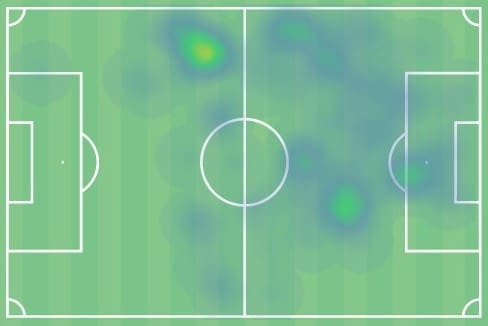
It is immediately obvious from this that Vilamala does not remain in one fixed position, and instead moves around, always trying to find spaces in the opponents’ half of the field. This is important when playing for Barcelona, as their tactics are built on players moving around and covering each other, and we saw last season how their midfielders often pushed forward when Spain striker Jennifer Hermoso dropped back to the midfield. This caused plenty of problems for their opponents, as they never knew which player was looking to advance behind them and which was going to receive the ball ahead of them. Vilamala tends to operate through the middle or on the left, and can come short to receive a pass or stay high up the pitch, keeping defenders back, so she has the flexibility that Barcelona thrive on.
Roles in the team
Looking more closely at the various roles Bruna Vilamala can play in will indicate how many systems she can fit into, which is another reason Barcelona Femeni rate her so highly.
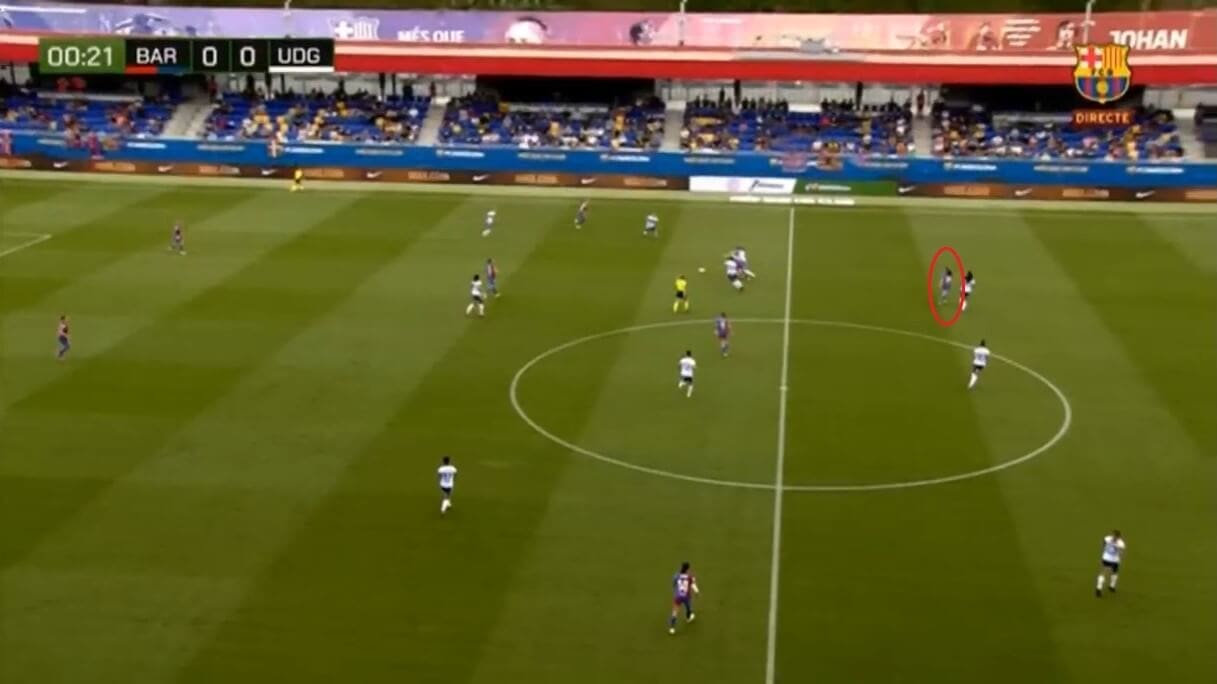
Firstly, as a general point, strikers need to be good at leading the line, and Vilamala’s positioning in this image not only gives her team a target player at the top of the pitch, but also keeps the Tenerife defenders away from the midfielders, therefore opening up a gap between the two lines for Barcelona to exploit. What is particularly notable is Vilamala’s positional discipline, as she doesn’t come back to gain possession, and instead maintains her distance to make the pitch as big as possible, making it harder for the defenders to deal with the attack.
Vilamala’s body position indicates that she is on the front foot, but is staying onside, and is ready to get forward as soon as the ball goes into the open space behind the Tenerife defence. Therefore, when leading the line, she plays a vital role in providing her team with a passing option in the final third, as well as ensuring that the defence are unable to close the ball down.
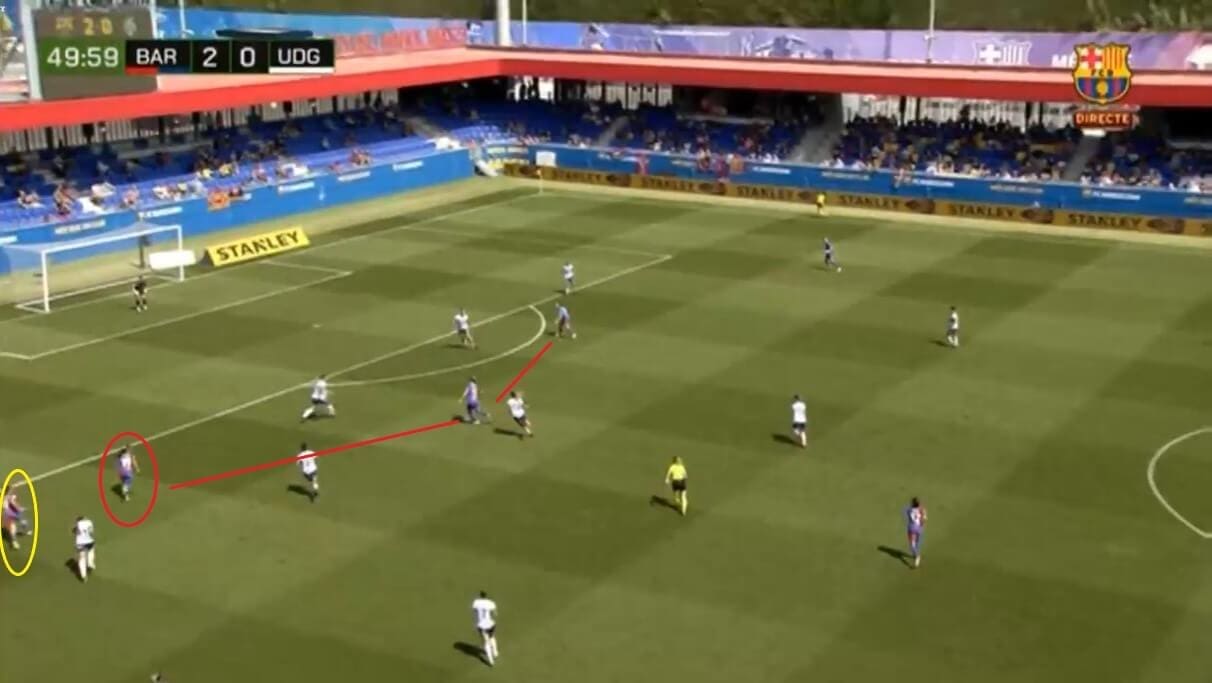
As mentioned already, Barcelona’s attacking tactics revolve around the midfielders, especially Aitana Bonmati and captain Alexia Putellas, getting forward and playing as the furthest player forwards when needed. As a result, Vilamala occasionally doesn’t play in the centre forward role, such as here, when she is in a wider position, again keeping her distance from the ball to make the pitch as big as possible. This structure forces the Tenerife defenders to stretch out, giving Barcelona gaps to run through, should the ball be passed through and into the box. On this occasion, it is passed across the pitch, towards the player in the yellow circle, with Vilamala moving out of the way to allow the pass to take place, but this still shows how Vilamala gives her team options, and how she can play in a forward line just as well as when she is on her own.
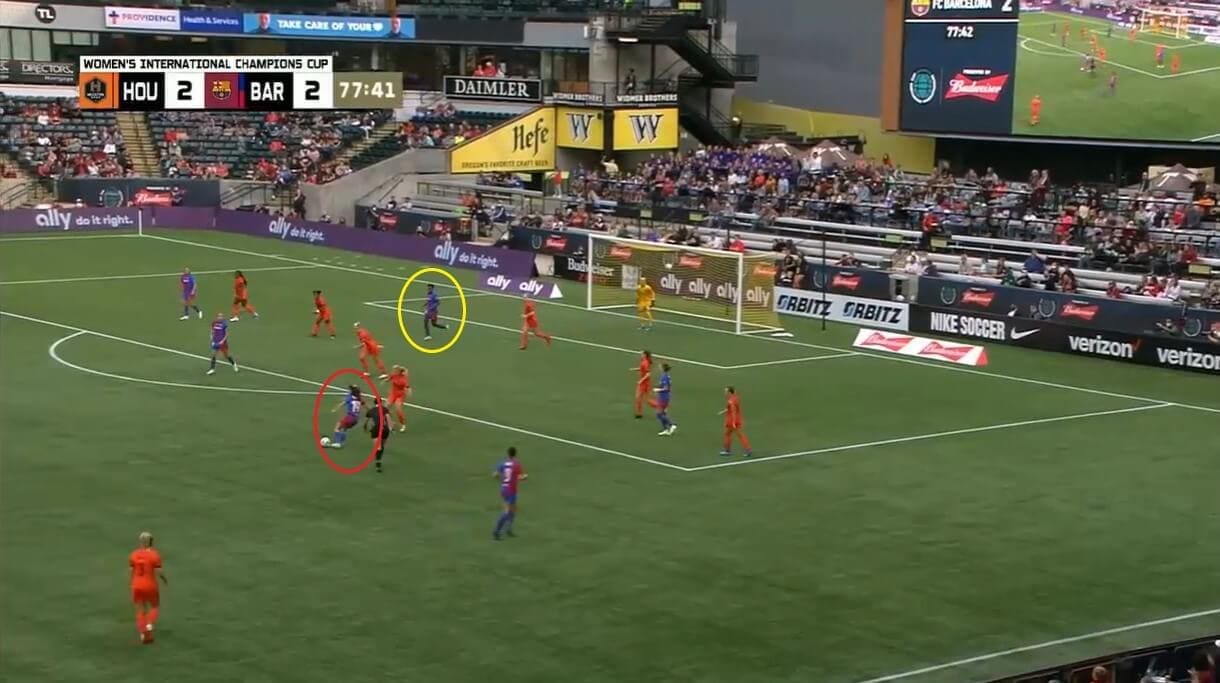
Vilamala is versatile in other ways too. Barcelona have different types of strikers in their squad, meaning the whole team needs to adapt during games, depending on who is on the field. We have already mentioned how Hermoso drops into the midfield, but former Liverpool Women and Arsenal Women forward Asisat Oshoala, who captains the Nigeria national team, tends to play as an out-and-out striker, staying higher up the field and pressing opposing defenders.
As a result, Vilamala is sometimes asked to get forward and sometimes needs to stay back, acting in a creative midfield role, as this image shows. This season, she currently has a 66.7% accuracy of passes to the penalty area, whilst her crossing accuracy is 33.3%, and both statistics demonstrate how she can operate in this role and provide just as much threat as when she is the lead striker.
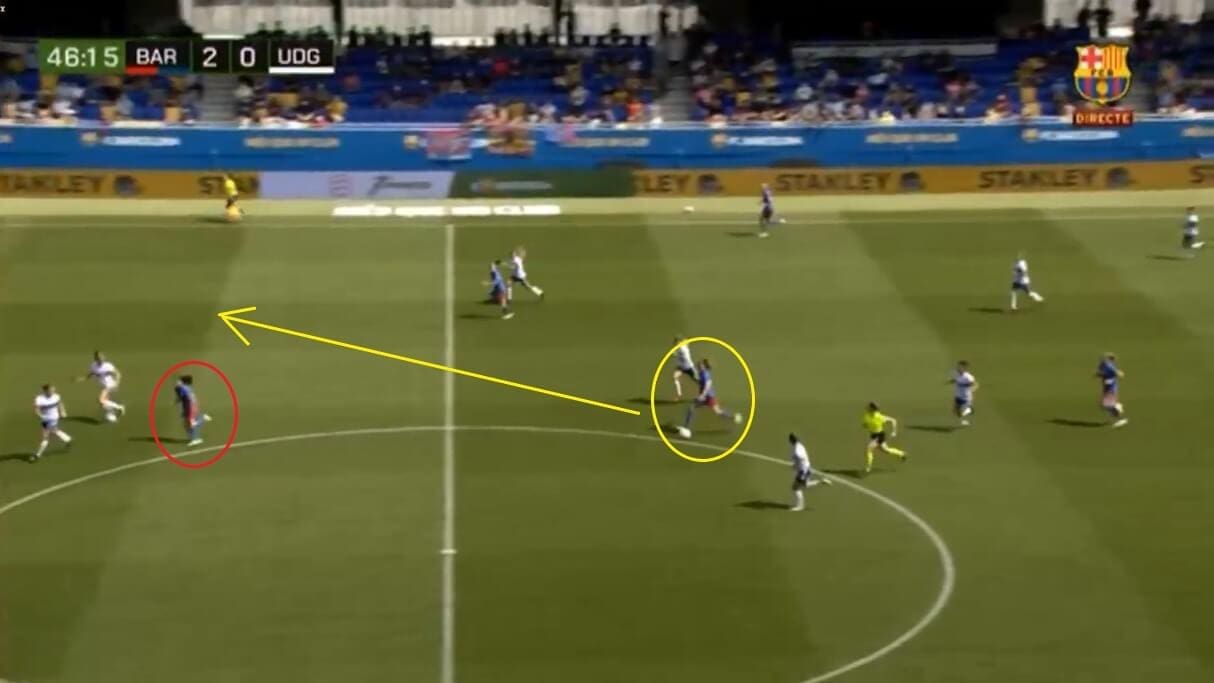
Vilamala’s movement also lends itself to Barcelona’s tactics in other ways. When the team are attacking forwards, she is sometimes used as a decoy, taking defenders out of position and allowing the ball to travel forwards into open space, as is happening here against Tenerife. Therefore, even when she doesn’t touch the ball, the young Spanish forward still plays a vital role in the team’s offensive tactics, and, with Hermoso out with an ankle injury suffered in pre-season training, Vilamala’s versatility means they may not miss her as much as previously expected.
Spatial awareness
Another key characteristic of a top striker is spatial awareness, knowing what is happening across the field and where the gaps are. This is something else that Bruna Vilamala has in abundance, as this analysis will now show.
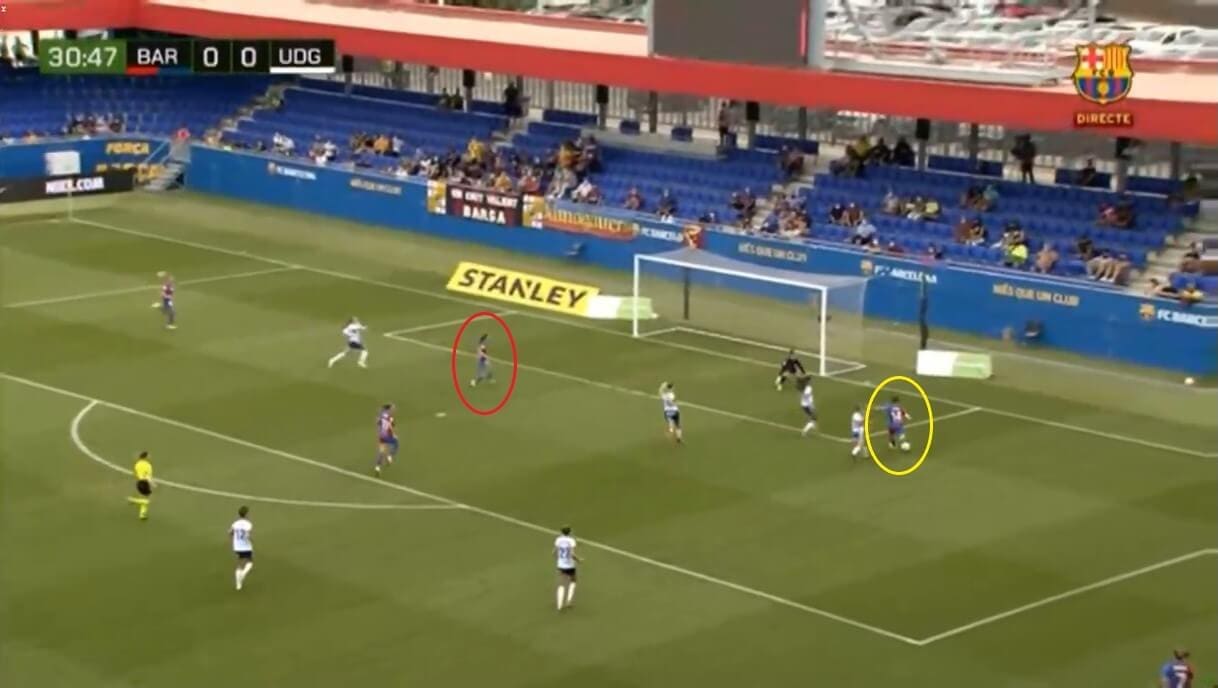
The main part of the field that the striker inhabits is the opponents’ box, and they need to be available to receive the ball in that area whenever the team is looking to create a goalscoring opportunity. Here, Vilamala knows where the space is, timing her run perfectly to connect with the ball at the right moment and score. If she had gone too early, the defenders would have been able to surround her, whilst going too late would have increased the likelihood of the opportunity being wasted. Aitana Bonmati, in the yellow circle, is also being closed down, so an option needed to be available quickly to keep the attack alive, and the fact that Vilamala gets all the elements right under this pressure shows why she has a big future in the game.
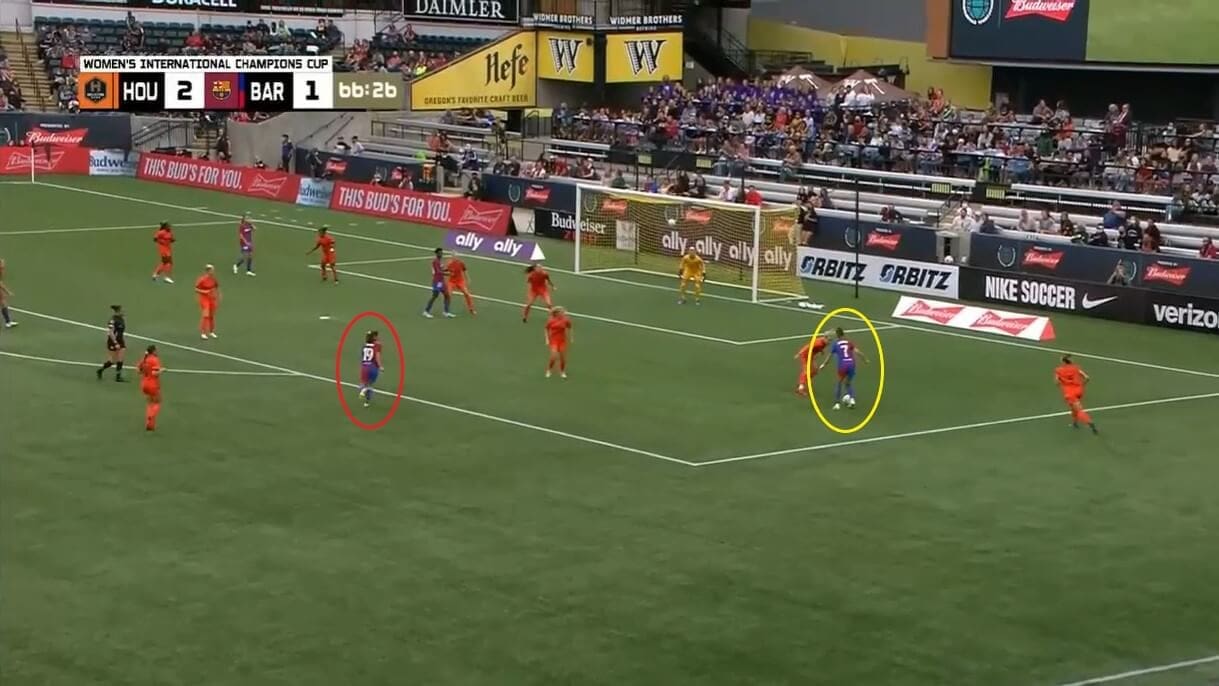
Her excellent spatial awareness is again demonstrated in this image but in a different way. This time, Houston Dash have crowded their goal area, limiting the space and preventing Barcelona from finding any of their key players inside it. As a result, Vilamala has had to adjust her position and is now waiting just outside the goal area, ready to receive the ball from Norway forward Caroline Graham Hansen, in the yellow circle. It might not be what Barcelona initially wanted to do here, but Vilamala has given them a way of keeping their attack alive. The fact that she gets into position early is also important because Hansen is being closed down in the same way as Bonmati was in the previous image, so the passing option again needed to be available at this exact moment.
Vilamala has time to control the ball and pick where to shoot at here but actually takes the opportunity with her first touch, sending it well wide of the net. This is where she perhaps needs to have more composure on the ball, keeping calm and not rushing when she doesn’t need to, and this will undoubtedly improve as her career progresses. She has got 50% of her shots this season on target, across three games, which is a good start for her, and this statistic will improve as the season goes on.
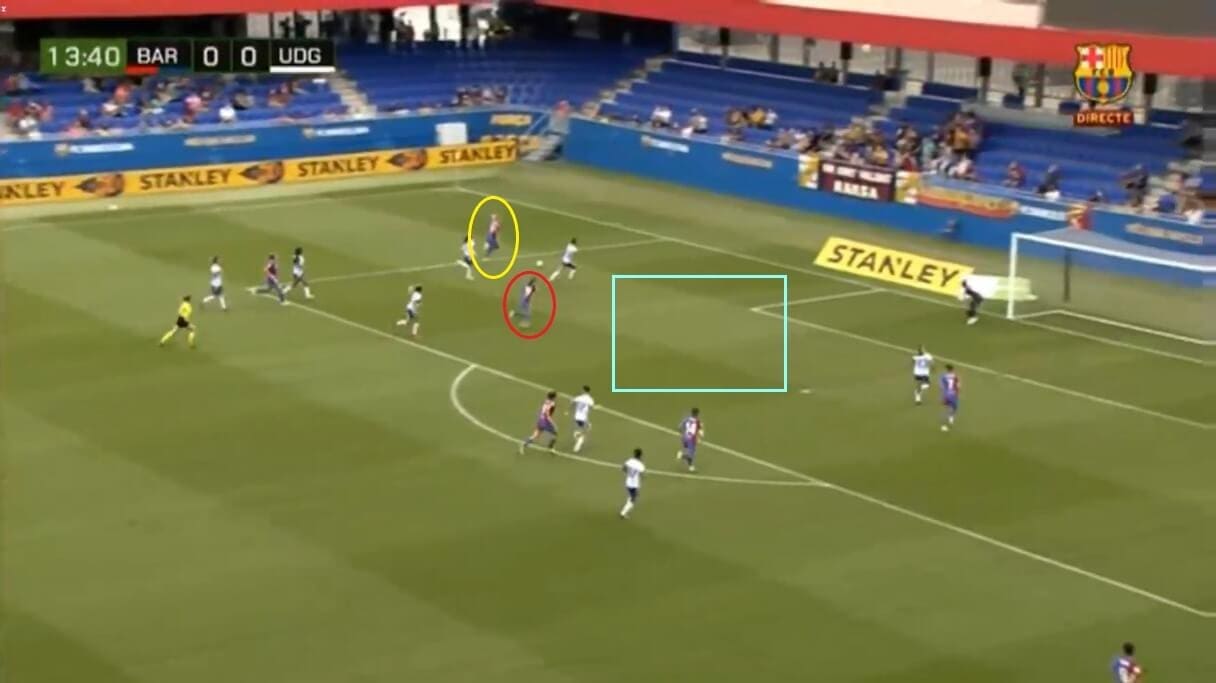
The two images we have looked at so far have shown Vilamala in space that was already available, but she occasionally needs to create it herself. Here, Barcelona are running forwards, trying to find a way through Tenerife’s defence, and Vilamala was initially looking to run through the middle of the attack, towards the goal, but notices how her teammate’s options are being cut off by the defenders. As a result, she slows down and holds her position, allowing her teammate to slide the ball between two of the Tenerife players and into her path.
The key thing here is that Vilamala’s ability to see what was happening around her opened up the space indicated by the blue square, in the so-called “corridor of uncertainty” (the area where goalkeepers and defenders need to communicate the most to avoid defensive mix-ups). It is harder for Tenerife to win the ball in that area, so we can again see how Vilamala’s awareness has been essential to Barcelona’s attacking play and is a key reason why many are tipping her as the next best thing in Spanish women’s football.
Working with teammates
We have already mentioned how Barcelona Femeni’s players all work together, with each knowing their roles and where they need to be during attacks. We have also already seen how Bruna Vilamala is a versatile player, able to operate in different roles and locate spaces in the final third, but her ability to work closely with teammates during games is perhaps the most important quality she possesses.
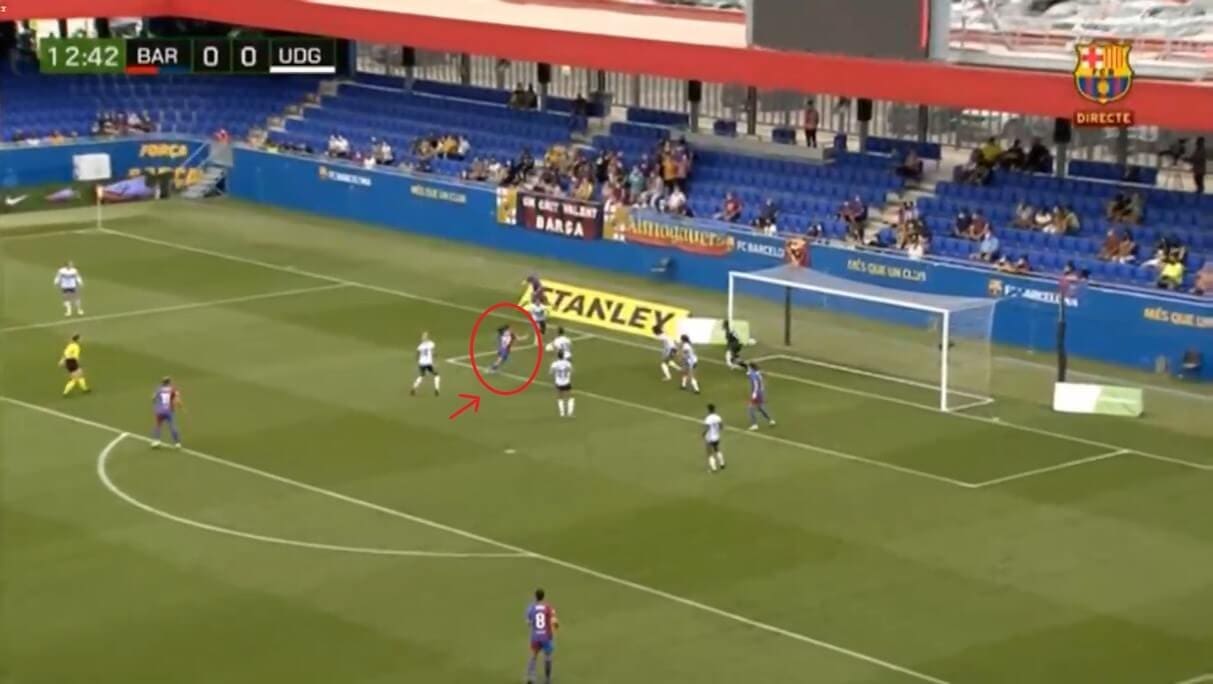
One key aspect of this is that Vilamala doesn’t crowd around the ball when teammates are in the same area as her. Here, Barcelona have advanced into the box, but the ball has gone loose in their attempt to pull it back into the middle of the goal area. This is when Vilamala comes alive, as she reaches the ball and gets a shot away before the defenders have had a chance to clear it. Vilamala has won 43.8% of her duels this season and has netted 12 times in her 14 league games since her debut, so opposing defences have to be alert when she is around because her effort here doesn’t miss by much.
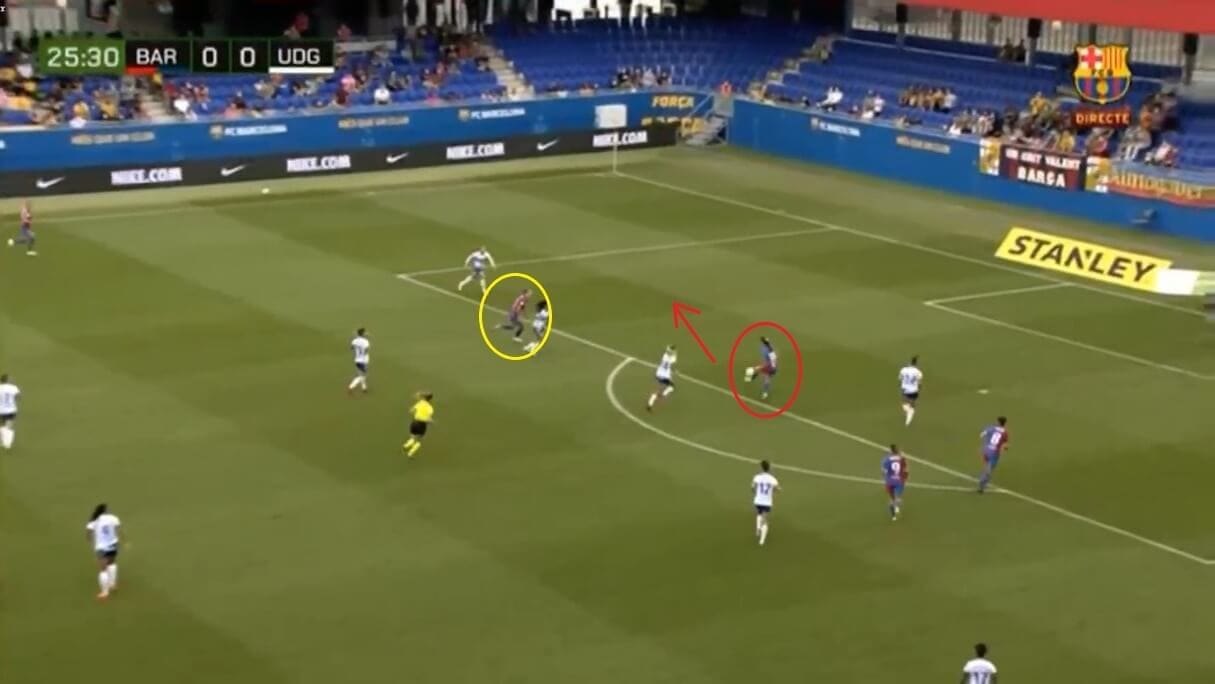
Vilamala works with teammates in other ways too. We know that Barcelona like to involve their attacking midfielders, Alexia Putellas and Aitana Bonmati, in attacking situations, and this image shows how Vilamala combines with them to create opportunities. Putellas, in the yellow circle, has chipped the ball into the striker here, with Vilamala’s first-time return pass weighted perfectly and put into the right area, allowing Putellas to shoot at the Tenerife goal from behind the defenders. This may sound like a simple point to make, but it is difficult to get these passes right, as they require both players to know instinctively what the other will do at each stage. Therefore, it is a clear indication of how Vilamala brings other players into the game when playing at the top of the field, and the quality she has when doing this is another reason that she is so highly rated.
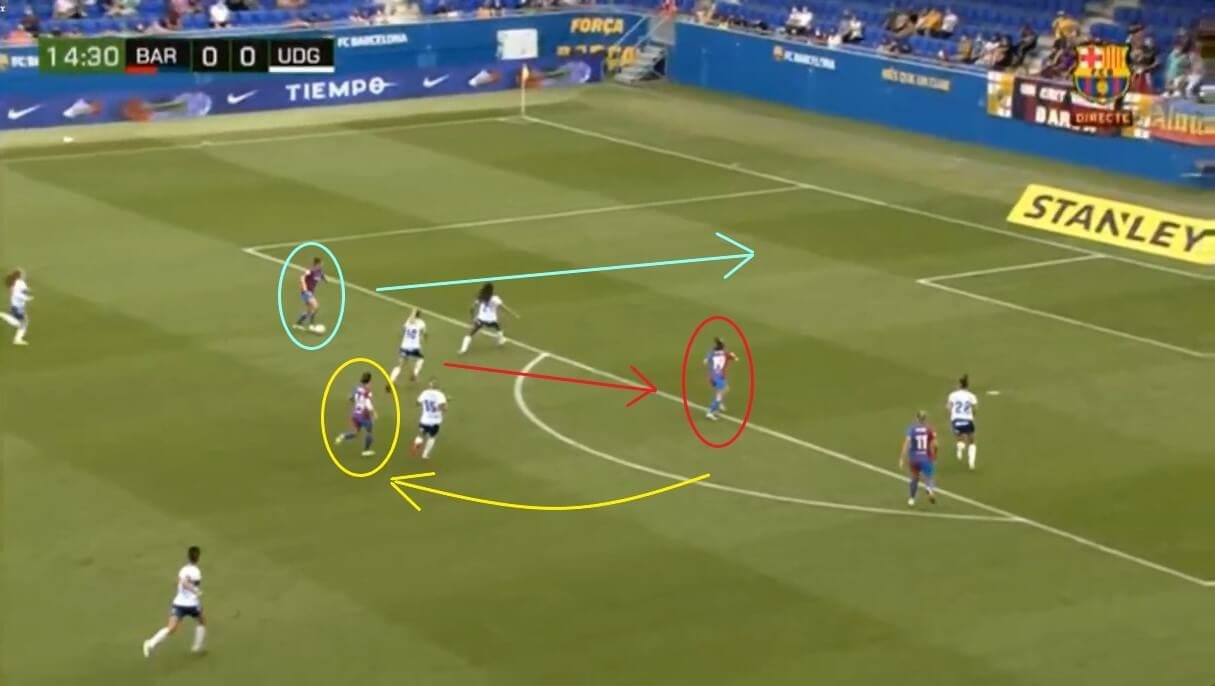
There are more ways that she links up with teammates, though, with this image showing the complex movement that goes into Barcelona’s attacking play. Aitana Bonmati, in the yellow circle, who was linked with Chelsea Women and Lyon Feminin this summer, has dropped back to receive the ball, before passing it out to Mariona Caldentey. Caldentey, in the blue circle, then runs forward and on the outside of the Tenerife defence, into an area where she can shoot at goal. However, the key thing here is that Vilamala, in the red circle, moves to cover the space Bonmati left, running between two of the defenders, and this takes their focus away from Caldentey, giving her more time to dribble through and take the shot.
This type of play again comes down to good communication and a free-flowing setup, with all players thinking together and helping to open up the spaces, and Vilamala has become a big part of that.
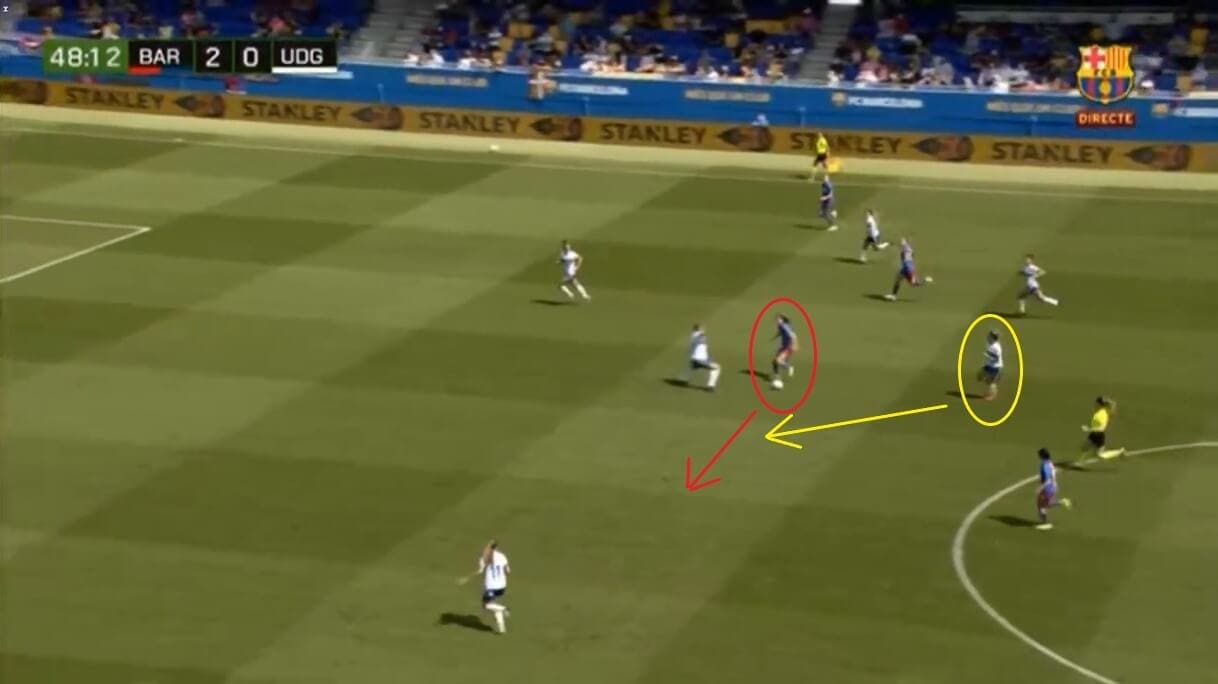
She is not only a striker who likes to run at goal with the ball though, as there are occasions when she can’t get towards the box, due to the defence closing her down and limiting her options. In these situations, she has the necessary composure to bring a teammate into the game, ensuring her team can continue their attack. However, on this occasion, her pass is not weighted well enough, with the Tenerife player behind coming in to intercept the ball and win back possession. We have already seen how Vilamala occasionally rushes shots when in good positions, and this comes down to the same lack of composure at times. It doesn’t need a lot of work to improve this, as she has a passing accuracy of 78.8% so far this season (63.6% forward and 92.3% back), but football is a game of fine margins, and the difference between drawing 1-1 and winning 2-1 can be a loose pass like this.
Conclusion
In conclusion, there is no doubting that Bruna Vilamala is a talented young player with a big future in the game. To establish herself in this Barcelona side is not easy, given the wealth of talent they have, but she possesses the raw qualities they look for in players; good movement, ball control, spatial awareness, an excellent range of passing, and the ability to link up with teammates and create opportunities. As for a comparison with their other strikers, she is a hybrid of Asisat Oshoala and Jennifer Hermoso; she has Hermoso’s movement and ability to drop into the midfield, as well as Oshoala’s ability to lead the line and manipulate opposing defences. Even when Hermoso returns from injury, it is highly likely that Vilamala will have a role to play in this season’s campaign, and it may not be long before Spain head coach Jorge Vilda has an eye on her too.

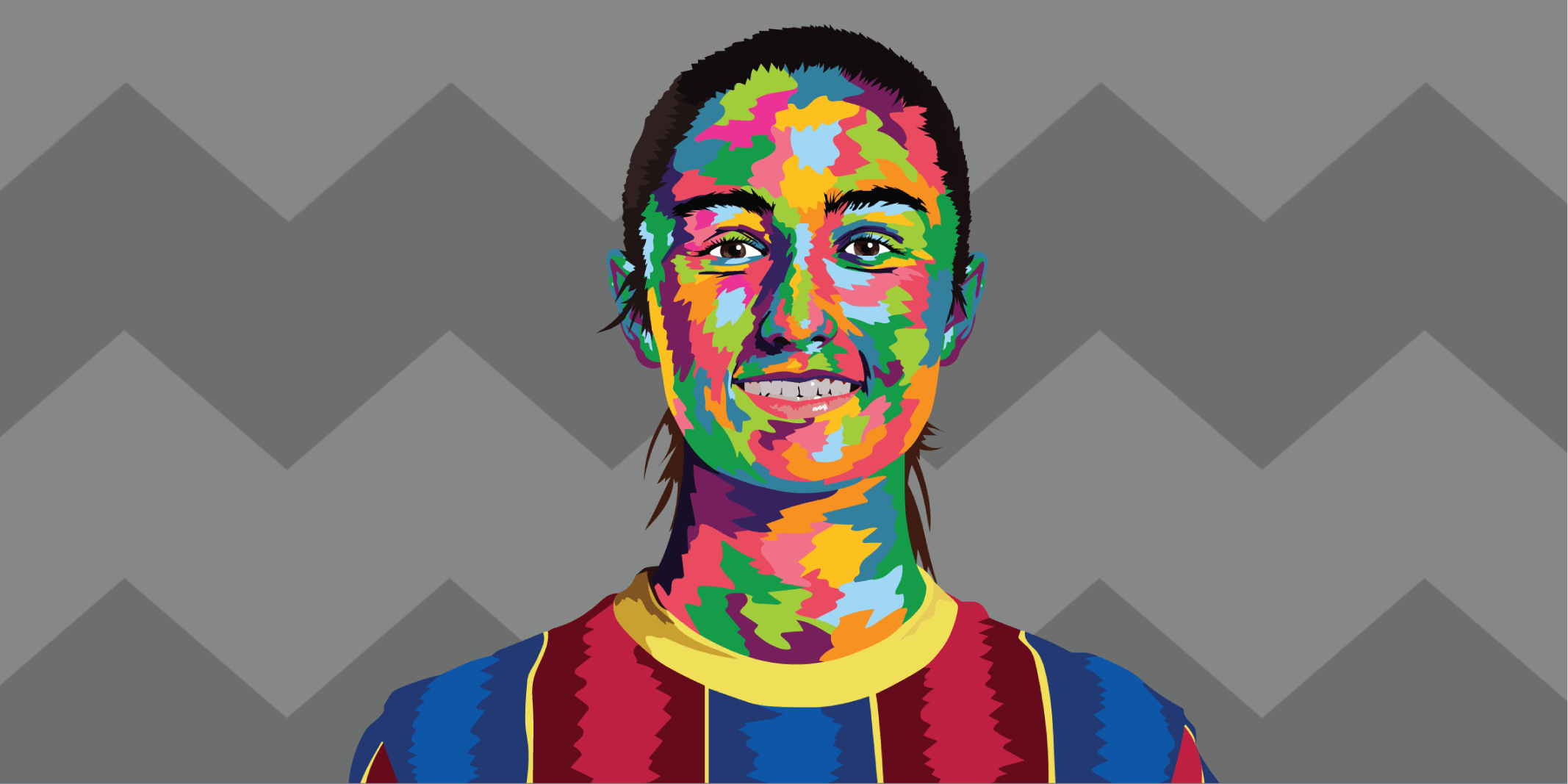



Comments